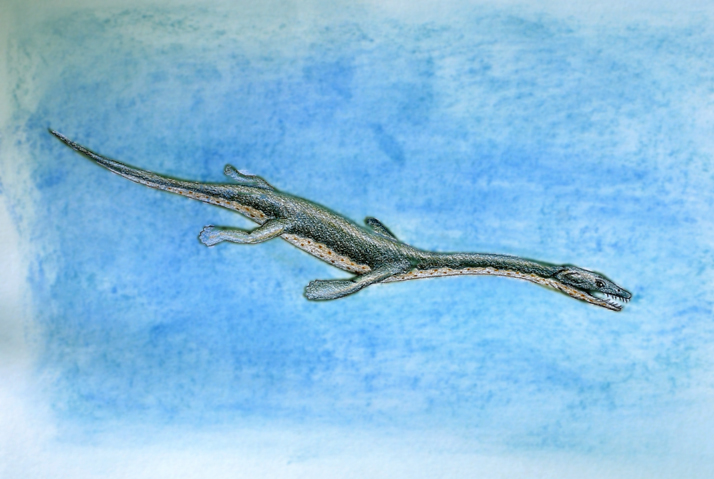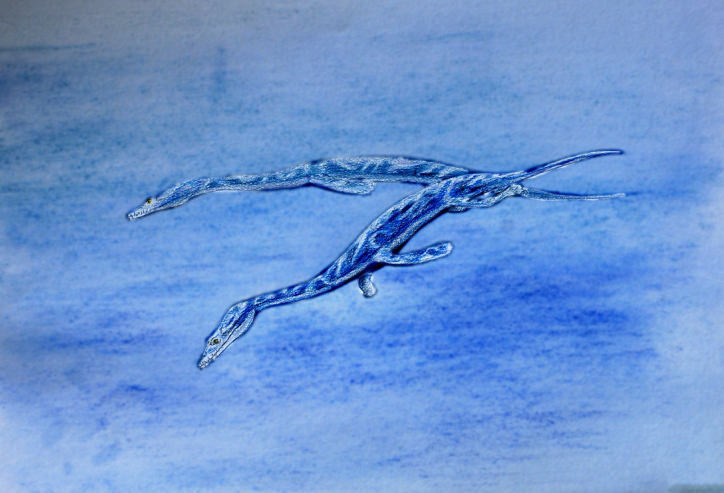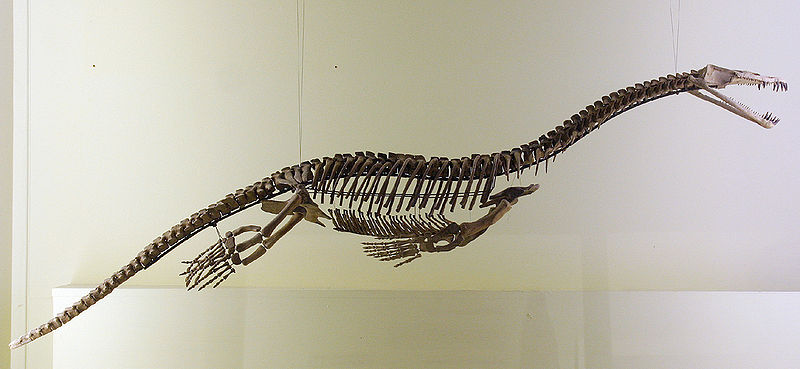[Recent Entries][Archive][Friends][User Info]
Below are the 6 most recent journal entries recorded in the "Сообщество, посвящённое ра" journal:| February 13th, 2012 | |
|---|---|
| 06:27 pm [industrialterro] [Link] |
Lariosaurus Lariosaurus is an extinct genus of nothosaur from the Triassic period of northern Italy. With a length of just 60 centimetres (2.0 ft), it was one of the smallest known nothosaurs. It was named in 1847 by Curioni, its name meaning "Lizard (from Lake) Lario". The nothosaur Eupodosaurus, initially classified as a stegosaurian dinosaur, is now considered synonymous with Lariosaurus. For a nothosaur, Lariosaurus was primitive, possessing a short neck and small flippers in comparison to its relatives. This would have made it a relatively poor swimmer, and it is presumed to have spent lots of time on dry land, or hunting in shallows. Lariosaurus unique among nothosaurs because its front legs were adapted into paddles, while the back legs remained five-toed. Further, based on skeletal findings of immature lariosaurs inside the adults, Lariosaurus is believed by many to be viviparous, or able to bear live young. Another Lariosaur skeleton was found with two juvenile placodonts of the Cyamodus genus in its stomach, giving an indication of its diet.
Ископаемые останки (1, 2, 3, 4, 5, 6):
( Далее ) Tags: Вымершие рептилии, Триас, диапсиды, завроптеригии, лепидозавроморфы, нотозавры |
| 05:56 pm [industrialterro] [Link] |
Ceresiosaurus Ceresiosaurus, meaning "Lizard of Ceresio" (Ceresio is the name of the Lake Lugano, in Switzerland), is an extinct genus of aquatic sauropterygian reptile belonging to the nothosaur order. Its fossils have been found in Europe, and was named by Bernhard Peyer in 1931. Ceresiosaurus lived during the Anisian stage of the middle Triassic. Olivier Rieppel suggested that Ceresiosaurus is a synonym of Lariosaurus. Ceresiosaurus was much more elongated than its relatives, reaching 4 metres (13 ft) in length, and had fully developed flippers with no trace of visible toes. It had multiple elongated phalanges, making the flippers much longer than in most other nothosaurs, and more closely resembling those of the later plesiosaurs. Ceresiosaurus also had the shortest skull of any known nothosaur, which further increased its resemblance to plesiosaurs. Although possessing a long neck and tail, Ceresiosaurus may not have swum by undulating its body. Analysis of the bone structure of the hips and powerful tail suggest that it instead propelled itself through the water much like a penguin. The evidence of pachypleurosaurs in the preserved stomach of Ceresiosaurus remains lend credence to the theory of it being a fast swimmer.
Размеры тела в сравнении с человеком:
Tags: Вымершие рептилии, Триас, диапсиды, завроптеригии, лепидозавроморфы, нотозавры |
| February 12th, 2012 | |
| 03:51 pm [industrialterro] [Link] |
Nothosaurus Нотозавр (Nothosaurus — "фальшивый ящер") — морской ящер эпохи среднего триаса, питавшийся рыбой. Обитал на территории нынешней России, Китая и Северной Африки 240—210 млн лет назад. Достигал в длину 3 метра, но найденные образцы N. giganteus достигали 6 метров в длину. Впервые был описан Мюнстером в 1834 году. Череп удлинённый и плоский, длинные челюсти снабжены острыми сцепляющимися зубами, некоторые из них в виде парных клыков, представлявших грозный капкан для рыбы. Конечности перепончатые, с пятью длинными пальцами, могли использоваться как для передвижения по суше, так и для плавания. Тело, шея и хвост длинные и гибкие. Мускулистый хвост помогал при плавании. Нотозавры достигали зрелости в возрасте трёх лет и жили до шести лет. Размножались нотозавры на берегах и в прибрежных скальных пещерах. Возможно, самки откладывали яйца в прибрежный песок, как современные черепахи. Учёные полагают, что одна из эволюционных ветвей нотозавров дала начало плезиозаврам — группе всецело морских рептилий, включавшей лиоплевродона, длинношеего криптоклида и других гигантских хищников. Нотозавры были в числе первых видов рептилий, переселившихся с суши в море, и состояли в близком родстве с плезиозаврами. Нотозавры вместе с плакодонтами относились к группе самых древних морских рептилий, они были вторично водными, т. е. путем эволюции вновь превратились из наземных в водоплавающих. Тем не менее, к воде они были приспособлены еще не идеально, а их конечности с перепонками служили больше для ходьбы, чем для плавания. Как и плакодонты, нотозавры жили и вымерли в триасе приблизительно 248-208 млн л.н., их можно считать предками появившихся позже плезиозавров, которые уже были приспособлены к воде идеально. Тело обтекаемой формы, довольно длинные шея и хвост позволяли нотозаврам преследовать рыбу или другую добычу. К тому же, конечности были снабжены длинными пальцами с перепонками, что помогало нотозавру грести и шлепать по воде. Задние конечности были не такими сильными и служили для направления движения. Нотозавр плавал, как выдра. Длинные и узкие челюсти нотозавра были снабжены острыми зубами в несколько рядов, которые забавно торчали наружу; такие зубы очень удобны для хватания и удерживания рыбы. У длины нотозавров разных видов довольно большая амплитуда: взрослая особь могла иметь длину как 4 м, так и 30 см. Высота ящера могла достигать трех метров. Можно предположить, что нотозавры вели образ жизни сходный с сегодняшними морскими львами. Скорее всего, они охотились в воде, а потом выползали на сушу и, довольные и сытые, отдыхали там. Как и большинство рептилий, самки нотозавра откладывали яйца на суше. Были даже найдены остатки молодого нотозаврика длиной всего 5 см. Детеныш имел типичные признаки развивающегося существа - большую голову, конечности, маленькое тело и все такое.
Репродукции (1, 2, 3, 4, 5, 6, 7, 8, 9, 10, 11, 12, 13):
( Далее ) Размеры тела в сравнении с человеком:
Ископаемые останки (1, 2, 3, 4, 5, 6, 7, 8):
( Далее ) Tags: Вымершие рептилии, Триас, диапсиды, завроптеригии, лепидозавроморфы, нотозавры |
| 03:42 pm [industrialterro] [Link] |
Serpianosaurus Serpianosaurus is an extinct genus of pachypleurosaur. Fossils have been found from the middle Grenzbitumenzone, the oldest strata of Monte San Giorgio, Switzerland, an area well known for its abundant pachypleurosaur remains. The locality dates back to sometime around the Anisian/Ladinian boundary of the Middle Triassic, around 237 Ma, with Serpianosaurus most likely occurring strictly during the earliest Ladinian. This makes it the oldest sauropterygian from Monte San Giorgio known to date. Certain aspects of its morphology also suggest it is one of the most basal forms. The genus can be distinguished from other closely related pachypleurosaurs on the basis of its proportionally large skull and straight jaw. Like many other pachypleurosaurs, sexual dimorphism can be seen in Serpianosaurus. Males and females are thought to differ in humeral size and shape. Any pachyostosis of the ribs is absent in Serpianosaurus specimens. It is closely related to the genus Neusticosaurus.
Tags: Вымершие рептилии, Триас, диапсиды, завроптеригии, лепидозавроморфы, нотозавры, пахиплеврозавры |
| 01:48 pm [industrialterro] [Link] |
Keichousaurus Keichousaurus is a genus of marine reptile in the pachypleurosaur family which went extinct at the close of the Triassic in the Triassic-Jurassic extinction event. The name derives from Kweichow (now Guizhou Province) in China where the first fossil specimen was discovered in 1957. They are among the most common sauropterygian fossils recovered and are often found as nearly complete, articulated skeletons, making them popular among collectors. Keichousaurus, and the pachypleurosaur family broadly, are sometimes classified within Nothosauroidea, but are otherwise listed as a separate, more primitive lineage within Sauropterygia. Keichousaurus, like all sauropterygians, was highly adapted to the aquatic environment. individuals of this genus ranged from 15 - 30 cm in length, and had both long necks and long tails, with elongated, five-toed feet. The pointed head and sharp teeth in this genus also indicate that they were fish-eaters. Some recovered specimens feature an especially developed ulna suggesting they may have spent some time on land or in marshes. In addition fossil evidence suggest also a pair of fossilized pregnant marine reptiles called Keichousaurus hui, show they had a mobile pelvis to give birth to live young rather than laying eggs. Keichousaurus hui was found in 1958 in Guizhou, China. This fossil is distinguished by its broad ulna which makes it unlike other European genera. The broad ulna increased the surface area of the forelimbs, making it more effective in locomotion. Keichousaurus shows many characteristics of its family Pachypleurosauridae such as its short snout and elongated temporal openings. Keichousaurus also had a long serpentine neck with a relatively small head and long tail. The anterior caudal vertebrae possess lateral transverse processes. The morphology of Keichousaurus is most like that of Dactylosaurus, showing long and narrow upper temporal openings that extends to the rear of the skull of which is not found in other pachypleurosaurids. Other differences from pachypleurosaurids include Keichousarus' more robust humerus, very broad ulna, and slight hyperphalangy in the manus. The sternum was also lacking in this animal, and the forelimbs were more paddled-shaped, possibly indicating a greater importance of the forelimbs in movement. The pectoral girdle was formed by the paired clavicles, interclavical, scapulae, and coracoids. Keichousaurus was a primitive quadrupedal tetrapod with limbs laterally placed to the body. Different parts of Keichousaurus grew at different rates, a phenomenon called allometric growth. The locomotion of Keichousaurus probably resembled (in part) the "underwater flight" that plesiosaurs employed. The flattened forelimbs would likely have acted as hydrofoils. The hindlimbs show less specialization, and may therefore have acted as stabilizers and control surfaces, such as is seen in extant sea turtles. The intermediate nature of the limb morphology implies that there was also, to some extent, the kind of 'crawling through the water' seen in small freshwater turtles. The powerfully built pectoral girdle allowed for the attachment of strong muscles, but their location beneath the shoulder favours the underwater flight model. Interestingly, despite the specialization of the limbs, the tail also shows adaptations to an aquatic existence. Lateral transverse processes of the anterior caudal vertebrae show that powerful muscles enabled the tail to beat or at least undulate from side to side. This would imply some distal lateral compression, but this is not recorded in soft-tissue preservation. The long neck was primarily concerned with prey-capture. The combination of powerful limbs and tail would have made K. hui an adept and maneuverable predator. Although there is no direct evidence, Keichosaurus was ovoviviparous (eggs form and hatch within uterus). Fossil Keichousaurus display a simplified elbow joint and a lack of ossification in the olecranon process of the ulna. This would make crawling up the beach to lay eggs awkward. Specimens at different developmental stages, found in the same type of sediment at the same locality, also support an ovoviviparous reproduction model. However, fossils have been found of female Keichosaurs with fetuses within the lower portion of the thoracic cavity. Their position implies that they are not victims of cannibalism. Nothosaurs (order Nothosauroidea) were Triassic marine sauropterygian reptiles that may have lived like seals of today, catching food in water but coming ashore on rocks and beaches. They averaged about 3 metres (10 ft) in length, with a long body and tail. The feet were paddle-like, and are known to have been webbed in life, to help power the animal when swimming. The neck was quite long, and the head was elongate and flattened, and relatively small in relation to the body. The margins of the long jaws were equipped with numerous sharp outward-pointing teeth, indicating a diet of fish and squid.
Ископаемые останки (1, 2, 3, 4, 5, 6, 7, 8, 9):
( Далее ) Tags: Вымершие рептилии, Триас, диапсиды, завроптеригии, лепидозавроморфы, нотозавры, пахиплеврозавры |
| 01:35 pm [industrialterro] [Link] |
Dactylosaurus Dactylosaurus is a genus of nothosaur in the family Pachypleurosauridae. Along with Anarosaurus, Dactylosaurus was one of the earliest known pachypleurosaurs to come from Europe. The nasal bones of Dactylosaurus meet and are broadly structured. The upper temporal fenestra is large and kidney-shaped. There are 17 cervical vertebrae and the cervical ribs have anterior processes. The maxillae of Dactylosaurus extended broadly up the side of the snout. The holotype specimen (MGUWR WR 3871s) of D. gracilis was only a partial skeleton, consisting of the anterior end alone. Because it differed slightly from the fossils of D. gracilis, it was first thought to belong to the species D. schroederi, which is now considered a junior synonym for juvenile D. gracilis. Once this was established, the juvenile fossil, which was found before the adult fossils, became the holotype. The one limb that was found (a left forelimb), was noted to have a slimmer radius and ulna than Neusticosaurus, a similar nothosaur from Europe. D. gracilis is the smallest known species in its family, which includes the much more recognized Keichousaurus, a nothosaur often remembered for its small size. The original holotype of D. gracilis is considered a juvenile, however the size of a nothosaur when its bones harden is used to show size, making the estimate as smallest member of its family still valid. Dactylosaurus lived in the Middle Triassic period during the Anisian faunal stage, of central Europe. In terms of geology, they are found in the lowest Muschelkalk layers, in and around the Gogolin Formation. Pachypleurosaurs were primitive sauropterygian reptiles that vaguely resembled aquatic lizards, and were limited to the Triassic period. They were elongate animals, ranging in size from 20 cm to about a meter in length, with small heads, long necks, paddle-like limbs, and long deep tails. The limb girdles are greatly reduced, so it is unlikely these animals could move about on land. The widely spaced peg-like teeth project at the front of the jaws, indicate that these animals fed on fish. Pachypleurosaurs were originally and are often still included among the Nothosaurs (Carroll 1988, Benton 2004). In some cladistic classifications however (Rieppel 2000), they are considered the sister group to the Eusauropterygia, the clade that includes the nothosaurs and plesiosaurs.
Tags: Вымершие рептилии, Триас, диапсиды, завроптеригии, лепидозавроморфы, нотозавры, пахиплеврозавры |






































